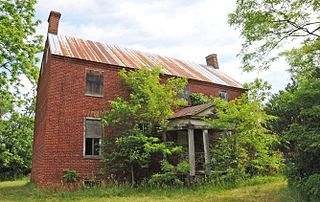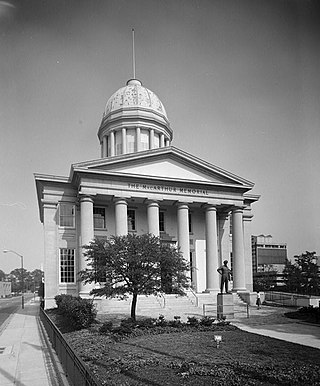
Haymarket is a town in Prince William County, Virginia, United States. The population was 1,545 as of the 2020 census.

Courtland is an incorporated town in Southampton County, Virginia, United States. It is the county seat of Southampton County.

Charles Morrison Robinson, most commonly known as Charles M. Robinson, was an American architect. He worked in Altoona and Pittsburgh, Pennsylvania from 1889 to 1906 and in Richmond, Virginia from 1906 until the time of his death in 1932. He is most remembered as a prolific designer of educational buildings in Virginia, including public schools in Richmond and throughout Virginia, and university buildings for James Madison University, College of William and Mary, Radford University, Virginia State University, University of Mary Washington, and the University of Richmond. He was also the public school architect of the Richmond Public Schools from 1910 to 1929. Many of his works have been listed on the National Register of Historic Places.

The Great Falls Grange Hall and Forestville School are two historic buildings that served as a Grange meeting hall and as a school located in Great Falls, Fairfax County, Virginia. The Forestville School was built in 1889 as a one-room school, and expanded in 1911 with the appendage of the Floris School. It is an L-shaped wood-frame structure covered in weatherboards and topped by a standing-seam metal cross-gable roof. After closing as a school in 1922, it served as a residence and then as the Great Falls Post Office from 1959 until 1982. The Great Falls Grange Hall was built in 1929, and is a 1+1⁄2-story brick building with a gable front. It features a front porch supported by concrete pillars in the American Craftsman style. Both buildings are owned by the Fairfax County Park Authority.

Ferry Plantation House, or Old Donation Farm, Ferry Farm, Walke Manor House, is a brick house in the neighborhood of Old Donation Farm in Virginia Beach, Virginia. The site dates back to 1642 when Savill Gaskin started the second ferry service in Hampton Roads to carry passengers on the Lynnhaven River to the nearby county courthouse and to visit plantations along the waterway. A cannon was used to signal the ferry, which had 11 total stops along the river. The first ferry service was started nearby by Adam Thoroughgood.

Edinburg Mill is a grist mill in Edinburg, Virginia. The three-story wood-framed building stands on Stony Creek, set on a limestone basement. A working mill until 1978, the original structure was built in 1848 by the Grandstaff family. It replaced an 1813 complex developed by Grandstaff that included a sawmill, grist mill and a carding operation. The present mill was almost burned during the American Civil War, when forces under Union general Philip Sheridan set fire to the mill as part of their scorched-earth campaign. Local women convinced the soldiers to salvage the mill's flour, and the fire was extinguished, saving the mill.

The Howland Chapel School is a historic school building for African-American students located near Heathsville, Northumberland County, Virginia. It was built in 1867, and is a one-story, gable fronted frame building measuring approximately 26 feet by 40 feet. It features board-and-batten siding and distinctive bargeboards with dentil soffits. The interior has a single room divided by a later central partition formed by sliding, removable doors. The building is a rare, little-altered Reconstruction-era schoolhouse built to serve the children of former slaves. Its construction was funded by New York educator, reformer and philanthropist Emily Howland (1827-1929), for whom the building is named. It was used as a schoolhouse until 1958, and serves as a museum, community center and adult-education facility.

The Mann House is a historic home located at 205 Hanover Street in Concord, Michigan. It is a Michigan State Historic Site and is listed on the National Register of Historic Places. It has been operated as a museum since 1970.

Vale School-Community House is a historic two-room school located near Oakton, Fairfax County, Virginia. It was built about 1884 and expanded with a second room in 1912. It is a one-story, two-room, wood-frame building on a stone and concrete foundation. It has a gable front with overhanging eaves, topped by a belfry with the school bell. Also on the property is a well built in 1951 and the former location of a privy constructed in 1884. The school closed in 1931 and was reopened as a Community House by the Vale Home Demonstration Club in 1935. The founder of the Vale Club was Florence Jodzies who has been honored via historical marker. In 2018, Mrs Jodzies was included on the Wall of Honor of The Virginia Women’s Monument, located in Richmond's Capitol Square.

Cobbs Hall is a historic plantation house located at Kilmarnock, Northumberland County, Virginia. It was built in 1853, on the foundations of an earlier dwelling of the same design. It is a two-story, five-bay, double pile brick dwelling with a gable roof. The front and rear facades feature similar porches supported by Tuscan order columns. The ends have two semi-exterior end chimneys flanking the peak of the gable. Also on the property are the contributing Cobbs Hall graveyard containing Lee family remains, the remains of a 1+1⁄2-story brick dwelling, and a brick meat house. Cobbs Hall is one of the noted Northern Neck plantations associated with the Lee family of Virginia since the middle of the 17th century.

Mt. Atlas is a historic home and national historic district located near Haymarket, Virginia, United States. It was built about 1795 and is a 2+1⁄2-story, three-bay, Georgian style, frame dwelling with a single-pile, side hall plan. It has a 1+1⁄2-story rear ell dated to the late-19th century and a two bay front porch. The house features a single exterior stone chimney, a metal gable roof, and a molded, boxed cornice with modillions. Also included in the district are a smokehouse and the sites of the former kitchen and a carriage house.

Locust Bottom, also known as Rollingwood Farm, is a historic home and national historic district located near Haymarket, Prince William County, Virginia. The main house was built about 1811, and is a two-story, four-bay, Federal style, brick dwelling with a single-pile, modified central-hall plan. It has end chimneys, a metal gable roof, a molded brick cornice, and a kitchen wing which predates the main house. The two-story rear frame addition was added in the late-19th century. Also included in the district are the shop, the carriage house, the two chicken houses, the brooder house, the milk house, the horse barn, the tenant house, corn crib, and the remains of a smokehouse.

Maple Hall is a historic home located near Lexington in Rockbridge County, Virginia, USA. The house was built in 1855 and is a two-story, three-bay, Greek Revival style brick dwelling on an English basement. It has a hipped roof and rear ell with a gable roof. It features a two-story pedimented front portico. The property includes the contributing two-story brick building which probably dates to the 1820s and a small log outbuilding. The home was purchased by John Singleton, who was then the owner of a boarding school in South Carolina, in April 2021. The building was then occupied by the therapeutic boarding school Maple Hall Academy. Maple Hall Academy abruptly closed in April 2024.

Old Stone Tavern, also known as Rock House, is a historic inn and tavern located near Atkins, Smyth County, Virginia. It was built by Frederick Cullop before 1815, and is a two-story, three-bay, limestone structure with a central-hall plan. A frame rear ell was added in the mid-19th century. It has a side-gable roof. The front facade features a mid-19th-century porch supported by chamfered columns connected on each level by a decorative cyma frieze and sawn balustrade. The tavern was built to accommodate travelers in the heavy migration through Cumberland Gap to the west in the early 19th century.

Rogers' Store, also known as Gwaltney's Store, is a historic general store located at Carsley near Surry, Surry County, Virginia. It was built about 1894, and is a two-story, three bay by three bay, Late Victorian frame building with a front gable roof. It features a full-width front porch supported by turned posts and a standing seam metal shed roof. Located directly behind the Rogers' Store is the Gwaltney's Store building. It was built in 1827, and is a 1 1/2-story, two room, gable front frame building. With the construction of the new store in 1894, the old store was converted to storage space. The store closed in 1952.

Flat Gap High School, also known as Flat Gap School Community Center, is a historic high school building located at Pound, Wise County, Virginia. It was built in 1935–1936 and is a one-story building with a three-part plan, consisting of a front gabled midsection and set-back, side-gable wings. The Classical Revival design references include rusticated stonework, molded cornice with gable returns, and a round-arched principal entrance with granite voussoirs and keystone. It ceased use as a school in the 1970s, and has been adapted for use as a community center.

Haller–Gibboney Rock House is a historic home located at Wytheville, Wythe County, Virginia. It was built in 1822–1823, and is a two-story, five bay late Federal style limestone dwelling. It has a side gable roof and a two-story frame ell terminating in a demi-octagonal end. The Rock House was used as a hospital during the Battle of Wytheville during Civil War. The building houses a museum sponsored by the Wythe County Historical Society.

Fredericksburg Town Hall and Market Square, also known as the Fredericksburg Area Museum, is a historic town hall and public market space located in Fredericksburg, Virginia.

Norfolk City Hall, also known as the MacArthur Memorial, is a historic city hall located at Norfolk, Virginia. It was built in 1847, and is a two-story, stuccoed and granite faced, temple-form building measuring 80 feet (24 m) by 60 feet (18 m). It features a front portico supported by six massive Tuscan order columns, and a gable roof topped by a cupola. The building housed city offices until 1918, and courtrooms until 1960.

The LaPorte City Town Hall and Fire Station is a historic building located in La Porte City, Iowa, United States. The town hall/fire station portion of the buildings was completed in 1876, five years after the town was organized. The two-story, brick structure has a gable roof hidden behind a metal false front. A two-story brick addition was built onto the north side of the building in 1911 for a town jail. The fire station was housed on the main floor of the original building where the two round-arch doorways are located. The doorways were altered in 1950 to accommodate larger fire vehicles. A single story concrete block addition was built at the same time. The fire department operated from here until 1968, and the large doorways were restored to their original arched form in the 1970s. The second floor of the original building was utilized as the town hall until the 1930s when it moved to the former La Porte City Station. The space was rented to the local high school for classrooms until 1974. After the fire department moved out the building the FFA Agricultural Museum began to occupy part of the building, until it eventually occupied the whole facility. The building was listed on the National Register of Historic Places in 1977. The museum moved to another building on Main Street in 2001.


























